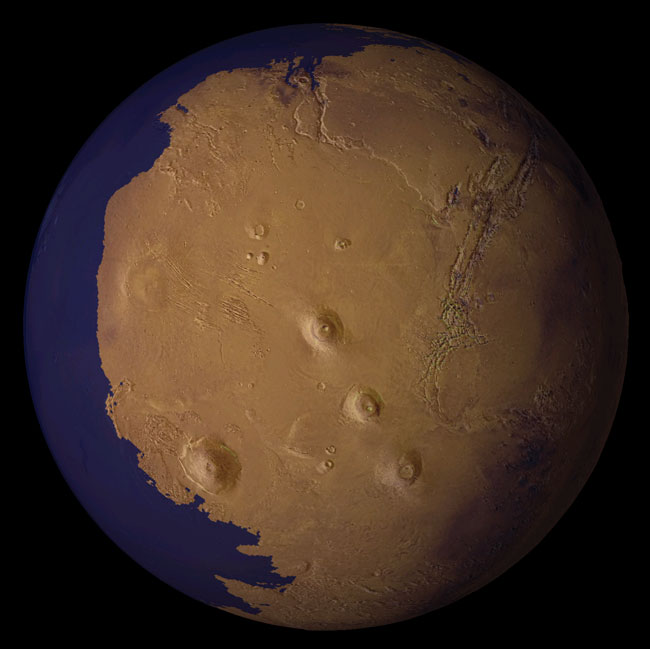Fire and Brimstone Helped Form Mars Oceans

The longstanding mystery of how oceans once formed on Mars could be solved by fire and brimstone.
Specifically, researchers now suggest that ancient volcanoes could have released brimstone — now more commonly known as sulfur — that warmed up the red planet enough for liquid water oceans in the early days of Mars. These findings might also shed insight on the young Earth, including the origins of life, scientists added.
Evidence of liquid water on the surface of Mars roughly 3.8 billion years ago implies that although its surface temperature now averages -51 degrees F (-46 degrees C), it was once relatively warm. Scientists have often proposed the red planet was enveloped during its youth in an atmosphere rich in carbon dioxide. Carbon dioxide is a "greenhouse gas," meaning it traps heat from the sun, warming up worlds such as Earth.
However, past findings suggest "that no amount of carbon dioxide on its own can get early Mars above the freezing point of water," said Harvard University planetary geochemist Itay Halevy. Also, an atmosphere rich in carbon dioxide would have led to massive deposits of limestone and other carbonate rocks littering the surface of Mars. The absence of such rocks has been a major puzzle.
Now Halevy and his colleagues propose in the Dec. 21 issue of the journal Science that volcanic gases loaded with sulfur could help solve both the puzzle of the missing rocks and the mystery of how Mars got warm enough for oceans.
The surface of Mars contains much higher levels of sulfur than Earth. This brimstone came from volcanoes that once erupted on the red planet. Indeed, the largest volcano in the solar system, Olympus Mons, is on Mars.
Compounds such as sulfur dioxide and hydrogen sulfide in volcanic gases could have acidified the ancient oceans of Mars enough to prevent the formation of carbonates, thus explaining their absence on the surface, Halevy said. In addition, sulfur dioxide is a potent greenhouse gas. If the atmosphere of early Mars was a hundredth or even a thousandth of a percent sulfur dioxide, that might have been enough to warm the red planet up for oceans.
Breaking space news, the latest updates on rocket launches, skywatching events and more!
Halevy noted that Earth and Mars were quite similar in their early days, and that sulfur dioxide could explain the scarcity of carbonate rocks on our planet during the Archean eon roughly 4 billion to 2.5 billion years ago.
"This has implications for how life originated on Earth during that period," he told SPACE.com. "Were oceans more acidic than at present? This raises a lot more questions."
Further experiments and computational modeling is needed to support these ideas, Halevy added.
- Gallery: Mars Imagined
- Top 10 Spaceflight Stories of 2007
- The Best Mars Images Ever

Charles Q. Choi is a contributing writer for Space.com and Live Science. He covers all things human origins and astronomy as well as physics, animals and general science topics. Charles has a Master of Arts degree from the University of Missouri-Columbia, School of Journalism and a Bachelor of Arts degree from the University of South Florida. Charles has visited every continent on Earth, drinking rancid yak butter tea in Lhasa, snorkeling with sea lions in the Galapagos and even climbing an iceberg in Antarctica. Visit him at http://www.sciwriter.us
